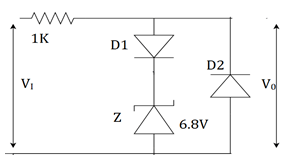This set of Electronic Devices and Circuits Questions and Answers for Entrance exams focuses on “Voltage Regulation Using Zener Diode”.
1. The percentage voltage regulation (VL) is given by_________
a) (VNL-VL)/VNL*100
b) (VNL+VL)/VNL*100
c) (VNL-VL)/VL*100
d) (VNL+VL)/VL*100
View Answer
Explanation: The change in the output voltage from no load to full load condition is called as voltage regulation, where VNL is the voltage at no load condition. It is used to maintain a nearly constant output voltage. If the regulation is high, the output voltage is stable.
2. The limiting value of the current resistor used in a Zener diode (when used as a regulator)
a) (R)min=[(Vin)max + VZ/R
b) (R)min=[(Vin)max-VZ]/R
c) (R)min=[(Vin)max-VZ]R
d) (R)min=[(Vin)max+ VZ]R
View Answer
Explanation: When the input voltage is maximum, the load current is minimum, the Zener current should not increase the maximum rated value. Therefore there should be a minimum value of resistor.
3. When the regulation by a Zener diode is with a varying input voltage, what happens to the voltage drop across the resistance?
a) Decreases
b) Has no effect on voltage
c) Increases
d) The variations depend on temperature
View Answer
Explanation: When the input voltage varies, the input current also varies. This makes more current to flow in the diode. This increase in the current should balance a change in the load current. Hence the voltage drop increases across the resistor.
4. In the given limiter circuit, an input voltage Vi=10sin100πt is applied. Assume that the diode drop is 0.7V when it’s forward biased. The zener breakdown voltage is 6.8V.The maximum and minimum values of outputs voltage are _______

a) 6.1V,-0.7V
b) 0.7V,-7.5V
c) 7.5V,-0.7V
d) 7.5V,-7.5V
View Answer
Explanation: With VI= 10V when maximum, D1 is forward biased, D2 is reverse biased. Zener is in breakdown region. VOMAX=sum of breakdown voltage and diode drop=6.8+0.7=7.5V. VOMIN=negative of voltage drop=-0.7V. There will be no breakdown voltage here.
5. Determine the maximum and minimum values of load current for which the Zener diode shunt regulator will maintain regulation when VIN=24V and R=500Ω. The Zener diode has a VZ=12V and (IZ)MAX=90mA.
a) 40mA, 0mA respectively
b) 36mA, 5mA respectively
c) 10mA, 6mA respectively
d) 21mA, 0mA respectively
View Answer
Explanation: The current through the resistance R is given by, I=(VIN-VZ)/R= (24-12)/500=24mA. (IL)MAX=I-(IZ)MIN=24-3=21mA .This current is less than (IZ)MAX. So, we assume that all the input current flows through the Zener diode. Under this condition, (IL)MIN is 0mA.
6. Determine the minimum value of load resistance that can be used in the circuit with (IZ)Min=3mA. The input voltage is 10V and the resistance R is 500Ω. The Zener diode has a VZ=6V 0and (IZ)MAX=90mA.
a) 1KΩ
b) 2.4KΩ
c) 1.2KΩ
d) 3.6KΩ
View Answer
Explanation: The I=(VIN-VZ)/R=(10-6)/500=8mA. (IL)MAX=I-(IZ)MIN=8-3=5mA. (RL)MIN=VZ/(IL)MAX=6/5m=1.2KΩ.
7. A Zener regulator has to handle supply voltage variation from 19.5V to 22.5V. Find the magnitude of regulating resistance, if the load resistance is 6KΩ. The Zener diode has the following specifications: breakdown voltage =18V, (IZ)Min=2µA, maximum power dissipation=60mW and Zener resistance =20Ω.
a) 0 < R < 500Ω
b) 77.8 < R < 500Ω
c) 77.8 < R < 100Ω
d) 18 < R < 500Ω
View Answer
Explanation: (PZ)MAX/rZ=(IZ)MAX2 . So, (IZ)MAX =60m/20=54.8µA. IL=VO/RL=18/6000=3mA.
RMAX=(VMin-VZ)/[( IZ)Min+( IL)MAX]=(19.5-18)/(2µ+3m)=500Ω.
RMin=(VMAX-VZ)/[( IZ)MAX+( IL)Min]=(22.5-18)/(54.8m+3m)=77.8Ω.
8. A transistor series regulator has the following specifications: VIN=15V, VZ=8.3V, β=100, R=1.8KΩ, RL=2KΩ. What will be the Zener current in the regulator circuit?
a) 4.56mA
b) 3.26mA
c) 4.56mA
d) 3.68mA
View Answer
Explanation: We know, VO=VZ-VBE=8.3-0.7=7.6V. VCE=VIN-V0=15-7.6=7.4V. So, IR=(VIN-VZ)/R=(15-8.3)/1.8m=3.72mA. IL=VO/RL=7.6/2000=3.8mA. IB=IL/ β=3.8mA/100=0.038mA. Finally, IZ=IR-IB=3.72-0.038=3.682mA.
9. When is a regulator used?
a) when there are small variations in load current and input voltage
b) when there are large variations in load current and input voltage
c) when there are no variations in load current and input voltage
d) when there are small variations in load current and large variations in input voltage
View Answer
Explanation: The regulator has following limitations: 1.It has low efficiency for heavy load currents 2. The output voltage changes slightly due to Zener impedance. Hence, it is used when there are small variations in load current and input voltage.
10. A transistor in a series voltage regulator acts like a variable resistor. The value of its resistance is determined by _______
a) emitter current
b) base current
c) collector current
d) it is not controlled by the transistor terminals
View Answer
Explanation: The principle is based on the fact that a large fraction of the increase in input voltage appears across the transistor so that the output voltage remains to be constant. When input voltage is increased, the output voltage also increases which biases the transistor towards less current.
Sanfoundry Global Education & Learning Series – Electronic Devices and Circuits.
To practice all areas of Electronic Devices and Circuits for Entrance exams, here is complete set of 1000+ Multiple Choice Questions and Answers.
If you find a mistake in question / option / answer, kindly take a screenshot and email to [email protected]
